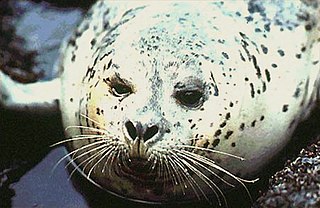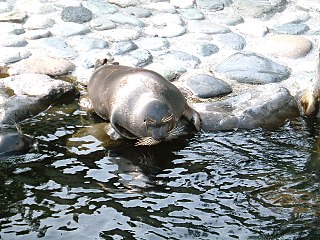 W
WThe Arctic ringed seal is a subspecies of ringed seals. Arctic ringed seals inhabit the Arctic Ocean, and are the most abundant and wide-ranging seal in the Northern Hemisphere. The ringed seal species is the smallest true seal, and gets its name from a distinctive patterning of light spots on dark grey colored fur. The ringed seal is commonly preyed upon by Polar bears, Arctic foxes, and Killer whales. Population estimates and survival rates are unknown, but average life expectancy is 15-28 years. Ringed seals have long been a component of the diet of indigenous people of the Arctic. Arctic ringed seals have been listed as threatened on the Endangered Species Act since 2012, and increasingly face loss of their habitat due to shrinking ice and snow cover.
 W
WThe Baikal seal, Lake Baikal seal or nerpa, is a species of earless seal endemic to Lake Baikal in Siberia, Russia. Like the Caspian seal, it is related to the Arctic ringed seal. The Baikal seal is one of the smallest true seals and the only exclusively freshwater pinniped species. A subpopulation of inland harbour seals living in the Hudson Bay region of Quebec, Canada, the Saimaa ringed seal and the Ladoga seal are found in fresh water, but these are part of species that also have marine populations.
 W
WThe Caspian seal is one of the smallest members of the earless seal family and unique in that it is found exclusively in the brackish Caspian Sea. They are found not only along the shorelines, but also on the many rocky islands and floating blocks of ice that dot the Caspian Sea. In winter, and cooler parts of the spring and autumn season, these marine mammals populate the Northern Caspian. As the ice melts in the warmer season, they can be found on the mouths of the Volga and Ural Rivers, as well as the southern latitudes of the Caspian where cooler waters can be found due to greater depth.
 W
WThe harbor seal, also known as the common seal, is a true seal found along temperate and Arctic marine coastlines of the Northern Hemisphere. The most widely distributed species of pinniped, they are found in coastal waters of the northern Atlantic, Pacific Oceans, Baltic and North Seas.
 W
WThe harp seal, also known as saddleback seal or Greenland seal, is a species of earless seal, or true seal, native to the northernmost Atlantic Ocean and Arctic Ocean. Originally in the genus Phoca with a number of other species, it was reclassified into the monotypic genus Pagophilus in 1844. In Latin, its scientific name translates to "ice-lover from Greenland," and its taxonomic synonym, Phoca groenlandica translates to "Greenlandic seal."
 W
WNeomonachus is a genus of earless seals, within the family Phocidae. It contains two species, the extant Hawaiian monk seal and the extinct Caribbean monk seal. Prior to 2014, all three species of monk seals were placed in the genus Monachus, but that was found to be paraphyletic.
 W
WPhoca is a genus of the earless seals, within the family Phocidae. It now contains just two species, the common seal and the spotted seal. Several species formerly listed under this genus have been split into the genera Pusa, Pagophilus, and Histriophoca. Until recently, Phoca largha has been considered a subspecies of Phoca vitulina but now is considered its own species. For this reason, the fossil history of the genus is unclear, and it has formerly been used as wastebasket taxon for a number of fossils of uncertain affinity.
 W
WPusa is a genus of the earless seals, within the family Phocidae. The three species of this genus were split from the genus Phoca, and some sources still give Phoca as an acceptable synonym for Pusa.
 W
WThe ribbon seal is a medium-sized pinniped from the true seal family (Phocidae). A seasonally ice-bound species, it is found in the Arctic and Subarctic regions of the North Pacific Ocean, notably in the Bering Sea and Sea of Okhotsk. It is distinguished by its striking coloration, with two wide white strips and two white circles against dark brown or black fur.
 W
WThe ringed seal, is an earless seal inhabiting the Arctic and sub-Arctic regions. The ringed seal is a relatively small seal, rarely greater than 1.5 m in length, with a distinctive patterning of dark spots surrounded by light grey rings, hence its common name. It is the most abundant and wide-ranging ice seal in the Northern Hemisphere: ranging throughout the Arctic Ocean, into the Bering Sea and Okhotsk Sea as far south as the northern coast of Japan in the Pacific, and throughout the North Atlantic coasts of Greenland and Scandinavia as far south as Newfoundland, and include two freshwater subspecies in northern Europe. Ringed seals are one of the primary prey of polar bears and killer whales, and have long been a component of the diet of indigenous people of the Arctic.
 W
WThe Saimaa ringed seal is a subspecies of ringed seal. They are among the most endangered seals in the world, having a total population of only about 400 individuals. The only existing population of these seals is found in Lake Saimaa, Finland. They have lived in complete isolation from other ringed seal species for around 9,500 years and have diverged into a morphologically and ecologically different subspecies of ringed seal. The population is descended from ringed seals that were separated from the rest when the land rose after the last ice age. This seal, along with the Ladoga seal and the Baikal seal, is one of the few living freshwater seals.
 W
WThe grey seal is found on both shores of the North Atlantic Ocean. It is a large seal of the family Phocidae, which are commonly referred to as "true seals" or "earless seals". It is the only species classified in the genus Halichoerus. Its name is spelled gray seal in the US; it is also known as Atlantic seal and the horsehead seal.
 W
WThe spotted seal, also known as the larga seal or largha seal, is a member of the family Phocidae, and is considered a "true seal". It inhabits ice floes and waters of the north Pacific Ocean and adjacent seas. It is primarily found along the continental shelf of the Beaufort, Chukchi, Bering and Okhotsk Seas and south to the northern Yellow Sea and it migrates south as far as northern Huanghai and the western Sea of Japan. It is also found in Alaska from the southeastern Bristol Bay to Demarcation Point during the ice-free seasons of summer and autumn when spotted seals mate and have pups. Smaller numbers are found in the Beaufort Sea. It is sometimes mistaken for the harbor seal to which it is closely related and spotted seals and harbor seals often mingle together in areas where their habitats overlap.